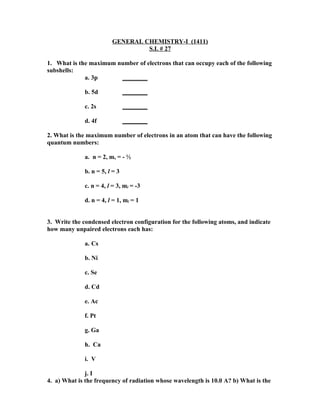
#27
- 1. GENERAL CHEMISTRY-I (1411) S.I. # 27 1. What is the maximum number of electrons that can occupy each of the following subshells: a. 3p ________ b. 5d ________ c. 2s ________ d. 4f ________ 2. What is the maximum number of electrons in an atom that can have the following quantum numbers: a. n = 2, ms = - ½ b. n = 5, l = 3 c. n = 4, l = 3, ml = -3 d. n = 4, l = 1, ml = 1 3. Write the condensed electron configuration for the following atoms, and indicate how many unpaired electrons each has: a. Cs b. Ni c. Se d. Cd e. Ac f. Pt g. Ga h. Ca i. V j. I 4. a) What is the frequency of radiation whose wavelength is 10.0 A? b) What is the
- 2. wavelength of radiation that has a frequency of 7.6x1010 s-1? 5. Label each of the following statements as true or false. For those that are false, correct the statement. a. Visible light is a form of electromagnetic radiation. b. The frequency of radiation increases as the wavelength increases. c. Ultraviolet light has longer wavelengths than visible light. d. Electromagnetic radiation and sound waves travel at the same speed. 5. a.) Calculate and compare the energy of a photon of wavelength 3.3µm with that of wavelength 0.154 nm. 6. Draw the electromagnetic spectrum for the wavelengths of light: